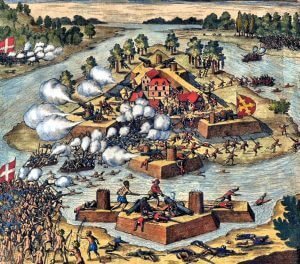
Don Pedro Menéndez de Avilés simultaneously built fortifications in Saint Augustine Bay and at La Florida’s planned capital of St. Elena on Parris Island, SC. Next he repaired and strengthened Fort Caroline, renaming it Fort San Mateo. Efforts were made by the Spanish in 1566 to bribe Indian tribes within the interior of Florida to turn over the Frenchmen, who avoided execution in 1765. Apparently, the Natives could not be bribed.
Fort San Mateo was to be the center of a planned mission system run by the Jesuits. The excellent harbor near Fort Mateo was to be a place where Spanish treasure fleets could find haven from English privateers and hurricanes. The fact that Spanish galleons could not even enter the St. Johns River is further evidence that neither Fort Caroline nor Fort Mateo were located there. The Jesuits attempted to convert Native villages near the outlets of the Altamaha, Satilla and St. Marys Rivers around 1568, but did not have much success.
Since the victims of the massacre were flying the flag of France, most Frenchmen, whether Protestant or Catholic, considered the murders to be an act of war by Spain. Had not France been badly divided by the Wars of Religion, it probably would have declared war on Spain. King Charles IX did nothing more than protest the massacre.
Captain Dominique de Gourgue, a Catholic nobleman in the French Army, was particularly incensed by the massacres. Perhaps friends or relatives of his were victims. He sold his assets then borrowed money from his brother in order to pay for an expedition to revenge the massacres. He chartered three ships and recruited a crew, ostensibly to sail to Cuba to purchase goods.
Upon arrival in the waters off Cuba, de Gourgue informed the crew of his true intentions and gave them an opportunity to vote on his plans. In April of 1568, his fleet sailed to what is now believed to be St. Marys Sound, but may have been St. Andrews Sound where the Satilla River flows into the Inter-coastal Waterway. The French base camp must have been far enough up one of these rivers to be concealed from Spanish ships passing by. De Gourgue then made contact with the Native Americans, who had been Fort Caroline’s allies. They did not like the arrogant Spanish.
There is strong possibility that Pierre Gambie was involved with Gourgue’s military operation. He paddled up the May River to make contact with provinces closer to the gold mines in the mountains in early 1565. He had not returned to Fort Caroline when it was attacked by the Spanish. Later on, he married the daughter of one of more powerful kings upstream on the May River. Apparently, he lived among the Utina for the rest of his life.
A combined force of Frenchmen and Indians attacked Fort San Mateo. They were not expecting such an attack and quickly surrendered. De Gorgue ordered all of the Spanish to be hung from the very same trees that were used to murder the garrison at Fort Caroline. He placed a sign up next to the site of their execution, which read in Spanish and French, “Not as Spaniards, but as murderers.” This sign was a ironic reference to the sign placed by Menéndez near the hanging bodies of the Frenchmen, which stated “Not as Frenchmen, but as heretics.”
Dominque de Gourgue expected to be treated as a hero when he returned to France. He was honored by the Huguenots and common folk, but ostracized by King Charles IX. He lost his military commission and fellow Catholic noblemen shunned him. He lived in poverty until 1572, when he was restored to the king’s favor. After that time he was occasionally given command of ships or military units until he died in 1584.
